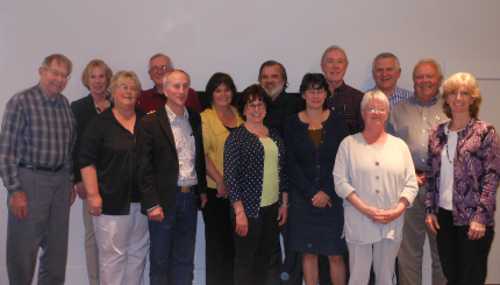LAKE COUNTY, Calif. – An increase in sexually transmitted diseases is raising concern for public health officials nationwide, with local officials also pointing to new and dangerous trends for infection.
Increased focus has been placed on STDs in April, which is STD Awareness Month.
A recent analysis from the Centers for Disease Control and Prevention shows that half of all new infections occur among young people aged 15-24, with the diseases costing American health care system nearly $16 billion in direct medical costs.
Federal health officials estimate there are 20 million new cases of sexually transmitted diseases annually, based on an analysis of eight common diseases – chlamydia, gonorrhea, hepatitis B virus (HBV), herpes simplex virus type 2 (HSV-2), human immunodeficiency virus (HIV), human papillomavirus (HPV), syphilis and trichomoniasis.
Total infections nationwide are estimated at 110 million, according to the CDC.
The greatest number of cases is of HPV, both in terms of new and total infections, based on the CDC analysis.
“We have seen a real increase in several sexually transmitted disease and it’s really quite alarming to me,” said Lake County Public Health Officer Dr. Karen Tait.
In a recently released state health report, it found that Lake County’s reported chlamydia infections were up by 52 percent.
Tait said Lake County has had a gonorrhea problem since late 2009, and now syphilis is on the rise, which she said is a particular concern. She called it “a real wake-up call about the risks of unsafe sex.”
She added, “It’s part of a bigger trend, it’s not just in Lake County.”
It was in 2009 that the county’s number of gonorrhea infections jumped sharply to 37 cases, compared to an average of 13 cases annually during 2004-2008, said Tait.
Of particular concern for Tait is a resurgence in syphilis. “This is the first time in my career that I have come across syphilis infections in the teenage age group. We need to do everything we can to stop this trend.”
She explained that syphilis is a disease that can appear to resolve yet, if untreated, silently results in long-term harmful effects, including neurologic and cardiovascular disease. Syphilis during pregnancy can result in serious harm to a developing fetus.
Tait said Lake County Public Health – assisted by the California Department of Public Health – conducted intensive contact tracing and worked to assure adequate treatment of those STD cases.
She said those efforts seemed to yield some short-term improvements, but cases have nonetheless have continued to increase.
Looking at state and local trends
Provisional data for Lake County shows peaks in gonorrheal infections during both the third and fourth quarters of 2012 that exceed the highest quarterly case count in 2009, Tait said.
By the end of 2012, 58 reported cases of gonorrhea were in the system, ranging in age from 13 years to 38 years, according to Tait. At the same time, chlamydia cases in 2012 totaled 196.
Tait said the highest rates of both chlamydia and gonorrhea are in the age 18-19 year age group, with the exception of gonorrhea in males occurring at a higher frequency in the 20-24 year age group.
There also was a recent case of chlamydia reported in the over-65 age group, which Tait said illustrates the fact that no age group is immune.
“It’s really distressing to see this trend, and it’s really hard to stop,” she said.
State officials also are seeing an uptick in cases of STDs, according to Heidi Bauer, MD, chief of the California Department of Public Health’s STD control branch.
In the state’s most receive STD surveillance report, which covers the year 2011, it reported 27,455 gonorrhea cases, 164,591 chlamydia cases and 2,448 instances of primary and secondary stage syphilis.
Bauer said the 2012 report on STD surveillance is in draft form. There always are some delays in the data, with both Bauer and Tait acknowledging that local information often is more up-to-date than the state’s.
However, based on her assessment of the 2012 data, “My impression is most things are increasing,” said Bauer.
Bauer said the ongoing increases in chlamydia that they’re tracking have many factors. “We actually have other data we look at to help us understand the trends.”
Testing is one of those factors, with Bauer explaining that in the mid 1990s more sensitive methods for testing became widely available for the disease. Because chlamydia is asymptomatic, many people didn’t know they had it until they took one of those new tests, Bauer said.
At the same as better testing became available in the 1990s, chlamydia screening became a national quality care measure, Bauer said. Routine screening is now recommended for females up to age 25.
Testing, she said, contributes to an “artificial trend” which doesn’t necessarily indicate greater chlamydia transmission. However, “We’re still seeing an increase,” Bauer said.
Increased screening for gonorrhea – which also can be detected in chlamydia testing – don’t account for the rise in cases for that disease, said Bauer.
“I don’t think we have any easy explanations,” she said.
Bauer said gonorrhea cases in gay men have increased disproportionately when compared with other groups. Gonorrhea in males is very symptomatic so they tend to seek care immediately.
As for syphilis, Tait said it has been “a real rarity” in Lake County. However, recent surveillance shows one teenage case and four cases in the 20s and up to age 30, with those stats not yet showing up in the state’s most recent reports.
“We're getting both male and female cases, which is also a little different from relatively high rates among men who have sex with men,” Tait said.
Bauer said that primary and secondary stage syphilis cases also are on the rise statewide, with the majority of cases involving men who have sex with men. “That’s where we’re seeing the predominant transmission in syphilis.”
State health officials also are seeing more cases in women, an occurrence which Bauer calls “a little more perplexing,” as they don’t have the same explanations as they do for the increase in males.
Tait offers several theories for local increases in STDs, including new opportunities for casual sexual encounters due to social media; “old-fashioned partying” that includes drug and alcohol use, which lowers inhibitions and can lead to dangerous behaviors; and a more casual attitude about the significance of STDs.
Working on solutions
Tracing and handling STD cases is complicated and resource intensive work for a small county health department like Tait’s.
She said the Lake County Public Health Division has one communicable disease nurse who receives and processes reportable disease information – including STDs.
That nurse, Tait explained, confidentially interviews those who are recently diagnosed to identify contacts who need to be warned and tested.
That process is one that often is thwarted by fear, unwillingness, stigma or just lack of information. She said that even though the infected person’s identity is not revealed, there still remains a reluctance to identify sexual contacts. In other cases, contacts’ names aren’t known or they are too numerous to count.
Tait said the agency has to prioritize how it uses its limited resources, so the greatest effort goes toward controlling syphilis, HIV and gonorrhea. In the case of Chlamydia infections, sexual contacts are only rarely tracked down and notified.
She said it’s essential that people who are at risk for acquiring a sexually transmitted disease seek regular screening through a health provider.
“People think there is a treatment for everything,” she said. “They are very much wrong.”
Tait said that in the case of gonorrhea, treatment options are fewer and fewer because of the development of drug resistance. “New antibiotics are not coming along fast enough. We face the scary prospect that we may some day not be able to effectively treat gonorrhea.”
She said pharmaceutical production problems have resulted in recent antibiotic shortages of common but important medications, such as doxycycline – an important alternative treatment for chlamydia and syphilis.
With so many challenges for tracking and cure, public health officials like Tait are urging prevention.
Hepatitis B and human papillomavirus have vaccines to help prevent infection, but those vaccines must be given before there is even one opportunity for sexual exposure. For that reason, she said infants routinely receive Hepatitis B vaccination and HPV vaccination is recommended as early as age 9 years.
However, Tait said vaccines are not available for most STDs, making avoiding exposure critical, since exposure to one STD often means exposure to others. That means education that leads to informed decisions is critical.
Tait said abstinence from all sexual contact is the only fail-safe protection against STD infections.
While she acknowledges that while talking about these subjects with teens is difficult for most parents, it’s also crucial. She said schools have an important role in educating children, but can’t take the place of families.
Condoms remain important in protecting against STDs, but Tait said they do not offer 100 percent protection, so every decision to have a sexual encounter needs to consider the risk.
Tait said minors 12 years and older are allowed, by law, to seek diagnosis treatment and now prevention (through vaccination) of STDs without parental consent. As family circumstances allow, she said teens are encouraged to talk to their parents.
For more information, call the Lake County Public Health Division at 707-263-1090 or toll-free (800) 794-9291 for an appointment; visit http://www.cdph.ca.gov/programs/std/Pages/default.aspx ; or to locate STD testing and treatment services anywhere, go to http://findstdtest.org .
Email Elizabeth Larson at This email address is being protected from spambots. You need JavaScript enabled to view it. . Follow her on Twitter, @ERLarson, or Lake County News, @LakeCoNews.











